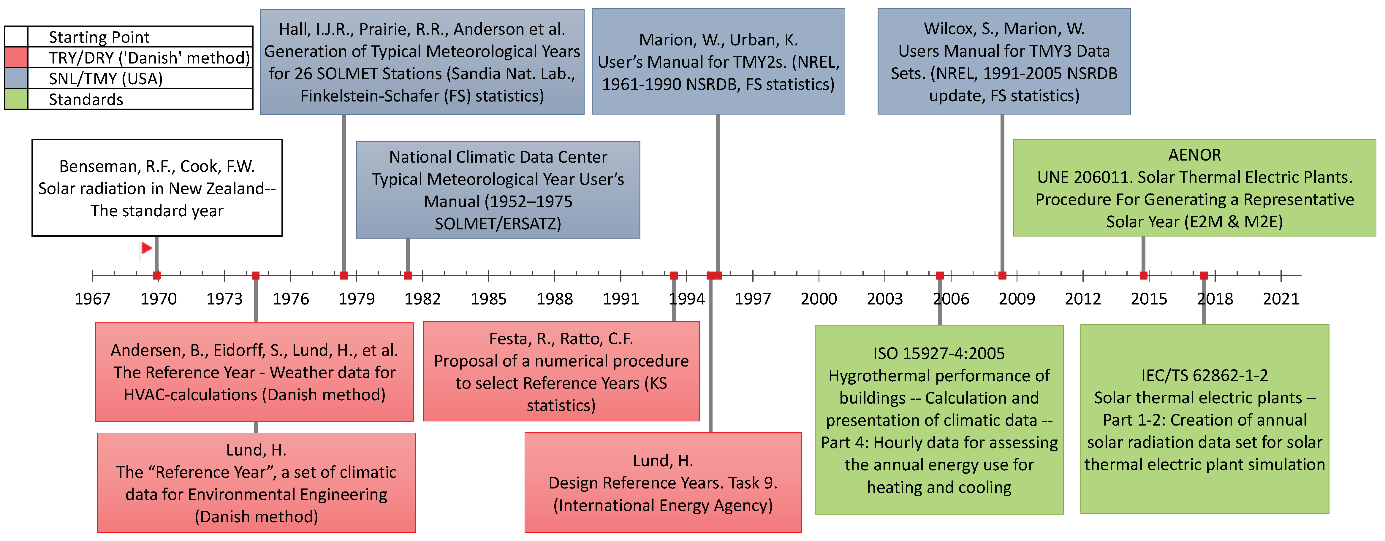Introduction
Time series of solar irradiance and other meteorological variables are essential inputs required to design, evaluate and optimize solar energy systems at a given location. Currently, the most common approach regarding their use consist of using these time series to build a “representative” solar radiation and meteorological year for the given location, and then use this representative year in the design, evaluation and optimization of solar energy systems at the location.
The starting point to build such a representative year is always a database with hourly or sub-hourly time series of solar irradiance and other meteorological variables encompassing many years. The basic idea is to concatenate the average months to generate an annual set representing “typical” conditions (Lourdes Ramírez et al., 2012). This annual set can be named in different ways depending mainly on the variables needed to build the final series and their weighting factors, the source of data (measured and/or modelled), or the application. Commonly used names are Representative Meteorological Year (RMY), Representative Solar Year (RSY), Test Reference years (TRY), Design Reference Year (DRY)(A Habte et al., 2014). However, the most common denomination is Typical Meteorological Year (TMY).
Figure 8 shows the timeline of the most relevant methodologies for the generation of a condensed year of meteorological data representing a long-term behavior.

(G) Policy making
TMY are useful for the assessment of the potential for solar energy systems on large areas, helping in the elaboration of regional or national policies for their deployment. These time series are usually required to estimate the energy generation and cost of different solar technologies.
The recommended features of the TMYs for this purpose are the following:
- 10 to 15 annual satellite derived solar radiation datasets for the TMYs series calculation
- 1-hour time resolution
- Uncertainty of solar radiation data: ≤ ±10 %
| Users | ||||||||
| Proyect developers needs at diferent plant stages | Other users | |||||||
| Category of product service | (A) Pre-feasibility | (B) Feasibility & Design | (C) Due Diligence Financing | (D) Plant Accep-tance Test | (E) Systems or Plant Operations | (F) Grid operators | (G) Policy makers | (H) Education / Outreach |
| LONG TERM REPRESENTATIVE TIME SERIES IN A SPECIFIC LOCATION | ✅ | ✅ | ✅ | ❌ | ❌ | ❌ | ✅ | ✅ |
|---|---|---|---|---|---|---|---|---|
Typical Meteorological Year
A TMY represents typical conditions, rather than extreme ones. A standard for the creation of a meteorological data set for the simulation of Solar Thermal electricity Plants was developed in the context of the International Electrotechnical Committee (Lourdes Ramírez et al., 2012)
Meteorological year of a PoE90
TMY it is not adequate to analyze adverse or worst-case conditions occurring at a location, an analysis that is usually required in profitability and annual payback assessments. For those analyses, the common practice is to generate a meteorological year in which the annual solar irradiation is expected to be exceeded by 90% of the years during the power plant`s lifetime (Fernández-Peruchena et al., 2018). The annual values is called PoE90 when the corresponding annual series is called MY90. It should be noted that annual solar irradiation values are not uniquely correlated to the energy yield of a solar plant. The yield is typically also influenced by other meteorological variables, such relative humidity, wind speed and direction, ambient temperature, etc. Therefore, the MY90 similar to the TMY must also include the time series of the rest of relevant meteorological variables.
In some cases, other series like MY75, MY95 or MY99 maybe required.
Long-term series
If a long-term time series of solar radiation data (measured or modeled) is available, an alternative to the elaboration and use of a TMY, is to find the average year, and the extreme years, using the average year as the TMY and the extreme low year at the MY90. In the case of good quality time series, this approach has the advantage that the analysis is performed with real years that actually happened.
Multiyear synthetic series
A recent approach for long term characterization of solar radiation is to use a large number of Plausible Meteorological Years (PMYs), synthetically generated yearly series that are consistent with the observed statistical characteristics of the solar resource at the project location, allowing for a stochastic assessment of the energy yield and a deeper characterization of the inherent variability of the solar radiation. This alternative approach consist on the use of synthetic multiple annual time series representing different scenarios of the solar resource at the site (Lourdes Ramírez et al., 2017). In a recent approach (Larrañeta et al., 2019) 100 annual sets of coupled GHI+DNI at 1-min resolution representing long-term performance of the solar radiation could be obtained from common satellite derived databases. This method extends the range of potential scenarios with respect to the observed ones, ensuring that the statistical characteristics observed in the input series are maintained.
PMYs could be a complementary product to TMYs, MY90 and MY99 providing a wider range of scenarios and facilitates the exploration of the impact of the climate change in the long term performance of the solar radiation. The resulting synthetic data sets can be used for feasibility assessments of solar projects to help engineers assess solar radiation variability and its impact on solar energy systems.
The relevant features for the application TMY and MY90 in the field of solar energy are:
- Extension of the available dataset for the typical year calculation.
- Available radiometric and meteorological variables for the calculation.
- Time resolution of the available data and the desired typical year resolution.
- Uncertainty of relevant meteorological data.

